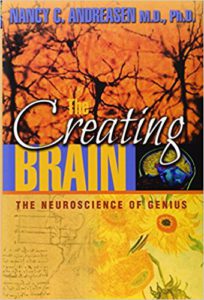 I am rereading much of my library to make decisions about which books to keep and which need to find another home before I move again. Several titles on my shelves focus on creativity. This refers, of course, to that aspect of human cognition that allows new ideas to be created.
I am rereading much of my library to make decisions about which books to keep and which need to find another home before I move again. Several titles on my shelves focus on creativity. This refers, of course, to that aspect of human cognition that allows new ideas to be created.
In Nancy Anreasen’s 2005 The Creating Mind: The Neuroscience of Genius, the author (who has a PhD in English literature and an MD) suggests creativity is characterized by: originality, utility, and a product. According to her definition, a new idea that is not useful or that is not instantiated in some way, then we are not dealing with a creative act.
This results in something of a paradox: A creative act must result in somethings that is new, but the new must pass become accepted by others. A very creative product may be such a radical departure from what is expected that it does not gain acceptance, so it has no utility. We see this effect when genius is not discovered until long after the genius has died.
In a similar way, we can differentiate normal creativity from extraordinary creativity. The individual who use existing practices and tools to accomplish ‘things” that are unusual or uncommon is displaying normal creativity. Many do the design activities we see engineers and business people and educators engaged in are demonstrating normal creativity.
The individual who finds new ways to communicate or conceptualize the world or who designs for new purposes is demonstrating extraordinary creativity.
As we think about education for a very unpredictable future, we must recognize an emerging role for pedagogy that provides opportunities for students to practice both normal and extraordinary creativity. The literature on promoting creativity seems to agree on certain “things” we can do in classrooms:
- Explore new ideas in-depth;
- Observe and describe in mindful ways;
- Ask deep questions;
- Seek diversity (in the environment and in the perspectives that we bring to ideas);
- Use our imaginations.